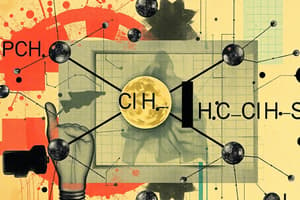Podcast
Questions and Answers
What type of bond forms when atoms with different electronegativities share electrons?
What type of bond forms when atoms with different electronegativities share electrons?
- Polar covalent bond (correct)
- Nonpolar covalent bond
- Metallic bond
- Ionic bond
What occurs in a solution with a pH of 5 compared to one with a pH of 7?
What occurs in a solution with a pH of 5 compared to one with a pH of 7?
- It has 100 times more protons (correct)
- It has no difference in proton concentration
- It has 50 times more protons
- It has 10 times more protons
In a balanced chemical reaction, what do equal concentrations of products and reactants imply?
In a balanced chemical reaction, what do equal concentrations of products and reactants imply?
- No reaction is occurring
- The reaction is in equilibrium (correct)
- The forward reaction is dominant
- The reaction is complete
Which type of bonds need to be broken for water to vaporize?
Which type of bonds need to be broken for water to vaporize?
Which statement regarding the role of water in acid-base reactions is correct?
Which statement regarding the role of water in acid-base reactions is correct?
Flashcards are hidden until you start studying
Study Notes
Fundamental Atoms in Organisms
- Carbon, Hydrogen, Oxygen, and Nitrogen comprise 96% of all organisms.
Covalent Bonding
- Covalent bonds form when atoms share electrons, leading to stable molecule formation.
Basic Atomic Structure
- An atom is structured with a nucleus containing protons and neutrons, with electrons orbiting around the nucleus.
Covalent vs. Ionic Bonds
- Covalent bonds involve sharing electrons, while ionic bonds arise from the electrical attraction between charged atoms.
Role of Water in Acid-Base Reactions
- Water serves as both an acid and a base, facilitating proton transfer in reactions.
Theory of Chemical Evolution
- This theory suggests that complex molecules originated from simpler compounds under early Earth conditions.
Nonpolar Covalent Bonds
- When atoms of equal electronegativity form a covalent bond, a nonpolar covalent bond results.
pH and Proton Concentration
- A solution with a pH of 5 contains 100 times more protons than a solution with a pH of 7.
Vaporization of Water
- Hydrogen bonds must be broken for water to vaporize.
Chemical Equilibrium
- Chemical equilibrium is characterized by equal concentrations of products and reactants, with ongoing forward and reverse reactions.
Spontaneity of Chemical Reactions
- Reactions become spontaneous when the reactants have lower potential energy compared to the products.
Balancing Chemical Equations
- The balanced equation for the reaction is: 1 CO2 + 6 H2O -> 1 C6H12O6 + 6 O2.
Truth of Statements about the Reaction
- The equation is balanced (True).
- The arrow indicates a reversible reaction (True).
- Water (H2O) is a product in the reaction (True).
Studying That Suits You
Use AI to generate personalized quizzes and flashcards to suit your learning preferences.




